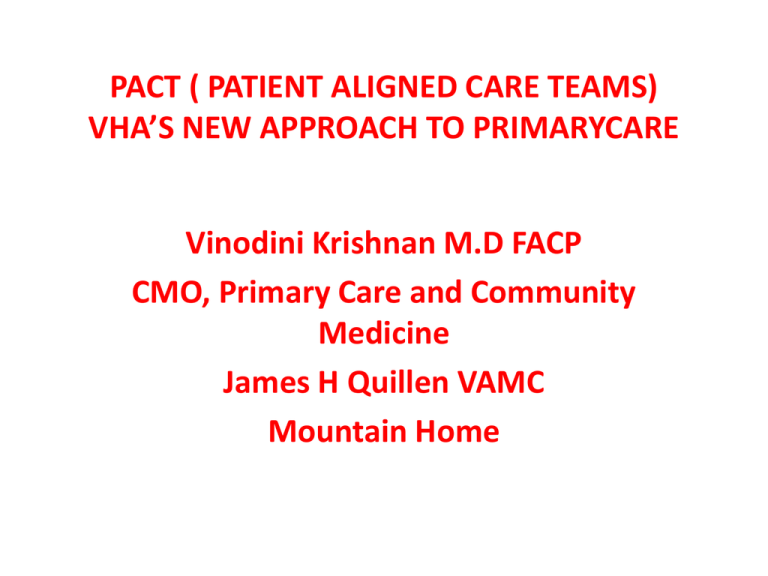PACT ( PATIENT ALIGNED CARE TEAMS) VHA’S NEW APPROACH TO PRIMARYCARE
advertisement

PACT ( PATIENT ALIGNED CARE TEAMS) VHA’S NEW APPROACH TO PRIMARYCARE Vinodini Krishnan M.D FACP CMO, Primary Care and Community Medicine James H Quillen VAMC Mountain Home Disclosure statement of Financial Interest • I, Vinodini Krishnan DO NOT have a financial interest/ arrangement or affiliation with one or more organizations that could be perceived as a real or apparent conflict of interest in the context of the subject of the presentation Acknowledgement • VHA PC Program Office • Gordon Schectman M.D: Acting Chief Consultant, PC • Richard Stark M.D: Director PC Clinic Operations • All the presenters at the various PACT learning sessions • http://www.youtube.com/watch?v=FTaw8aTE -7g • “ The good physician treats the disease, the great physician treats the patient who has the disease” Sir William Osler Patient-Centered Care VA is changing the way health care is delivered by shifting from a problem-based health care system, to one that is patient-centered and healing Key Components • Personalized Health Planning • Whole Person; Integrative Strategies • Behavior Change and Skill Building That Works 6 Patient Aligned Care Team Replaces episodic care based on illness and patient complaints with coordinated care and a long term healing relationship Takes collective responsibility for patient care Is responsible for providing all the patient’s health care needs Arranges for appropriate care with other specialties THE PRIMARY CARE TEAM Future of VA Health Care Past Present Future VA VA VA “What can I fix?” “How can we help what is wrong with you?” “How can we help you live the life you want to live?” Physician Clinical Team Veteran, Family and Health Care Team Case-Based Paper Medical Record Disease-Based Electronic Medical Record Whole-Person Electronic Health Record “We’ll address your immediate concern.” “You have a risky problem, please follow this plan to improve by your next visit.” “We can design your personalized health plan to meet your goals.” 8 The Patient’s View of Primary Care Access • I can get care when and how I need it Relationship over time Comprehensive services • I have a Team who knows me as a person • My Team takes care of the bulk of my health needs Coordination • My Team coordinates any care I need in the health system Patient Aligned Care Team Access Offer same day appointments Increase shared medical appointments Increase nonappointment care Care Management & Coordination Focus on high-risk pts: oIdentify oManage oCoordinate Improve care for: oPrevention oChronic disease Improve transitions between PCMH and: oInpatient oSpecialty oBroader Team Practice Redesign Redesign team: oRoles oTasks Enhance: oCommunication oTeamwork Improve Processes: oVisit work oNon-visit work Patient Centeredness: Mindset and Tools Improvement: Systems Redesign, VA TAMMCS Resources: Technology, Staff, Space, Community Other Team Members Clinical Pharmacy Specialist: ± 3 panels Clinical Pharmacy anticoagulation: ± 5 panels Social Work: ± 2 panels Nutrition: ± 5 panels Case Managers Trainees Integrated Behavioral Health Psychologist ± 3 panels Social Worker ± 5 panels Care Manager ± 5 panels Psychiatrist ± 10 panels Other Team Members For each parent facility HPDP Program Manager: 1 FTE Health Behavior Coordinator: 1 FTE My HealtheVet Coordinator: 1 FTE Teamlet: assigned to 1 panel (±1200 patients) Monitored via Primary Care Staffing and Room Utilization Data report in VSSC • Provider: 1 FTE • RN Care Mgr: 1 FTE • Clinical Associate (LPN, MA, or Health Tech): 1 FTE • Clerk: 1 FTE Panel size adjusted (modeled) for rooms and staffing per PCMM Handbook Patient 11 “Ways In” a practice OLD New e-mail Phone Visits Visits Changes in Primary Care Past PACT (Patient Aligned Care Team) The patient has one provider The patient has a team Care delivered only by provider Care delivered by team members Focus on visits Focus on overall health Most care delivered by visits New care delivery routes and tools Virtual visits uncommon Phone, telehealth visits, secure messaging common Continuity inconsistent Continuity consistent High risk patients get routine care Identify and manage high risk patients Hospitalizations common Hospitalizations less frequent Care not well coordinated Care coordinated throughout the system Prevention not stressed Prevention and health promotion essential Huddles and Team Meetings Huddles • Every Day • 10 Minutes • All Teamlet Members and Teamlet Social Worker • Identify Priorities for the Day • Communicate, Clarify, Assign • Tie Up Loose Ends from Prior Day 14 Huddles and Team Meetings Team Meetings • Once a Week • One Hour • Teamlet, Social Worker and Others as Related to Agenda • Agenda Multidisciplinary team meetings to help manage complex health care problems of veterans 15 Access: Traditional • Saturated schedules • Triage and rework often with high intensity resource • Multiple appointment types • Needs for “urgent”, “routine” and intermediate not met • Capacity: Overbook and “over there” • Continuity: Fine if you wait 7/12/2016 Open Access PACT Continuity: Every patient sees their own provider/team member Capacity: Future schedule is truly open • Backlog has been eliminated • Increase non-appointment care • Increase shared medical appointments • Right team member engaged with right patient’s needs • Right needs addressed by right tool (phone) Creating Schedule Space • Work Harder = add capacity temporarily • Work Smarter = reduce provider demand – Improve continuity – Reduce NS rate – Extend RVI – Schedule phone visit – Delegate tasks to others – Use group visits – Increase self care Contingency Plans • Predict and respond to variation in demand between days – Seasons • Plan for variation in supply between days – Short Term – Long Term • Plan for variation of demand and supply WITHIN the day Shared Medical Appointments • • • • • One-on-one care with observers 15-20 patients in 90 – 120 min. Patients learn from staff and from each other Appeals to about ½ of those offered option Requires substantial planning & help When to Schedule an Appointment? 1. Is a physical exam needed? 2. Is this a “relationship” visit? 3. Is there a need for a critical conversation? The harder the problem, the more valuable the appointment strategy. Delivering Telephone Care in PACT • 30% patient care can be done by telephone • Telephone Care by all team members needs to be legitimized, formalized and accepted. • Scheduled time on appointment grids & unscheduled visits • Documentation of Telephone Care via telephone stop codes, telephone clinics, coding/encounters and progress notes supports VERA allocation & workload. POSTER Why Secure Messaging? • 62% of Veteran population have access to the Internet • Veterans are requesting timely access to their health information • Veterans want to play an active role in partnering with primary care providers to manage their healthcare Goals of Secure Messaging • Improved Quality: patient-provider partnership promoting health, wellness, and informed decision-making. • Improved Veteran Satisfaction: patients’ desire this type of automated service for enhanced efficiency, convenience, and satisfaction. • Improved Access: reduction in unnecessary office visits, expansion of case management and ease of access to services. • Improved Patient Growth: new generation of veterans are highly acclimated to the electronic environment Increase Supply • Look inside of the appointment – What is the work? – Who is doing it now? – Who could be doing it? • What is the provider doing that someone else could do? PACT Access Opportunities Secure Messaging Face to Face Visits Telephones Group Visits • Transitions-DC/ED • Chronic Illness • HPDP • Acute/Episodic • Follow up FtF visit • Face to Face • Telemed (CVT) TeleHealth • Telemedicine (CVT) • CCHT • Store & Forward Why Patients Call? Questionconcern about medication 38% Test Results 9% Next Step in Care? 14% ChronicLongterm Medical Issue 12% Urgent Medical Issue 14% Clarification of Information on Last Visit 13% Source: 2009 Voice of the Veteran Survey Care Management • Prevention and Health Promotion • Chronic Disease Management • Transitions – Inpatient – Primary Care – VA Outpatient Specialist Community 30 The Global Burden of Chronic Diseases • Chronic diseases are the largest cause of death in the world. • In 2002, the leading chronic diseases—cardiovascular disease, cancer, chronic respiratory disease, and diabetes— caused 29 million deaths worldwide • Global response to the problem remains inadequate – elevating chronic diseases on the health agenda of key policymakers – persuading them of the need for health systems change. Yach et al. JAMA, June 2, 2004—Vol 291, No. 21 Chronic Disease in the United States • Affects more than 180 million Americans • Accounts for more than 75 cents of every dollar spent and nearly 2/3 of the total healthcare expense • By 2030: Anticipated increase in healthcare costs tied to chronic disease, 25% to 54% • 45% of the American population have at least one chronic condition 32 Care Management Medication reconciliation Making sure the right things get done at the right time by the right person in the right place Labs and other tests Institutional knowledge • Orders • Results Patient’s Care Needs Contacts, local resources Consults and Referrals • Pre-requisites • Results Protocols, SOPs, standing orders 34 Coordination Emergency Department Diagnostic Tests PCMH Teamlet Specialty Care Patient Family In-Patient Care Home Care Tools of Care Coordination Care Plan for Life Patient Registries Email Alerts Flags and Clinical Reminders Templates Huddles Team Meetings Screening Tools Community Resources Protocols: • RN Driven • LPN/HT Driven • Clerk Driven 36 CCHT uses Evidenced Based Disease Management Protocols (DMP) Existing DMP’s Developing DMP’s • • • • • • • • • • • • Diabetes CHF COPD HTN Major Depression Substance Use Disorder Weight Management TBI Palliative Care Dementia PTSD SCI 37 Katherine Corrigan, MD Bridging Primary and Specialty Care (Any Discipline) Shared Vision • Patient-Centered • Team-Based • Coordinated • Continually Improving Shared Agenda • Meet face-to-face • Involve key players • Educate • Seek common goals 38 Outpatient and Inpatient Care Coordination: How To Do It Admission Notification • PCMM or CPRS alerts • ED visits • Admissions • Phone call • Review admission list Service Agreement with Hospitalists Nursing Policy/Procedure • Contact PACT soon after admission • PACT involvement in care • Contact PACT before discharge Pre-discharge involvement • Visit inpatients • Virtual chart review • Meet with discharge planners 39 VA and Non-VA Care Coordination: Directory of Community Services/Resources How To Do It • Point of Contact • Phone numbers • Standard location Contact Local providers • • • • Identify POC What When How Contact local hospitals • • • • Identify POC What When How 40 The Journey for a Patient with Diabetes 85% P R E V E N T I O N Diagnosis Initial Continuing Management Care Non diabetes admissions new complic ations heart disease life events stroke treatment change eg insulin ED EVENTS Pregnancy Severe hypos Institutional care ketoacidosis protenuria Eye problems Foot issues PC P ROVIDER CLERK CLINICAL A S S O C I AT E RN C A R E MANAGER F A M I LY 42 Practice Redesign Principles Balance supply and demand for tasks and processes Synchronize patient, provider, equipment, room, and information Predict and anticipate patients needs Optimize staff, rooms and equipment Manage constraints Synchronizing to the Appointment Time How do we get the provider, the patient, the equipment, the information to an available room-on time, every time? Room Provider Patient Equipment 10:00 Appt. Information Supply: The Link Between Access and Practice Redesign Improved access leads to more efficient office processes Increased supply leads to improved access Supply More efficient processes increase supply VHA Preventive Care Program 1 How will we know? • • • • • • • • 47 Readmission rates Ambulatory care sensitive admissions ED monthly rates Prevention (package) rates Outcome data by chronic disease Patient satisfaction Staff satisfaction Provider satisfaction PACT Implementation at a Glance 48 High Performing PACTs: Outcome Measures 43% 47% Better Performance Better Performance 6% decrease (8% FY11) 6% decrease (4% FY11) 50 ACP Medical Home Builder VHA Average Oct-09 69% Jul-11 80% High Performing PACTs: Access Measures 6 days 6% Better Performance Better Performance Mountain Home Nine sites for Primary Care 300 1500 500 400 2200 Existing CBOC ROC 1100 Planned clinic 22,000 1800 15,000 53 Mountain Home Renewing Our PACT with Veterans


